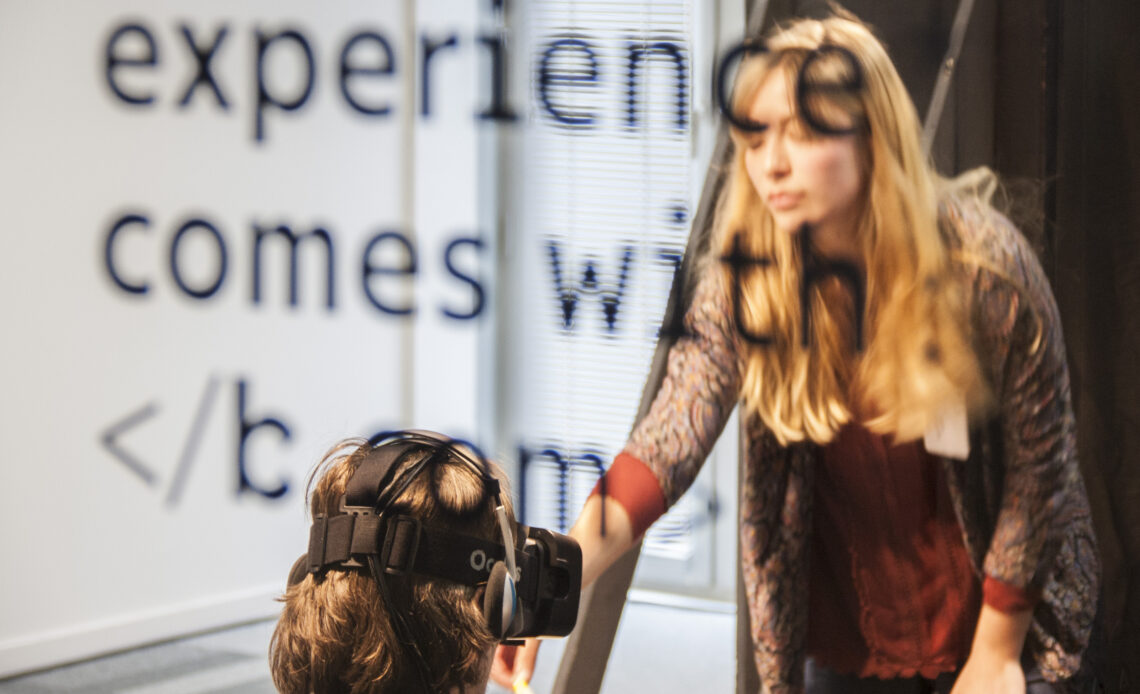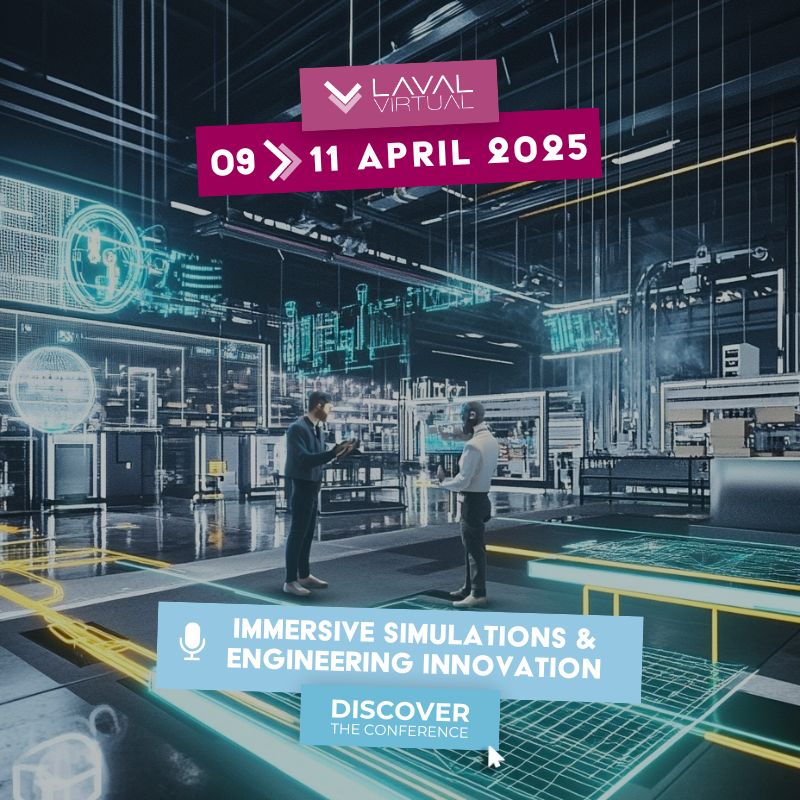
b<>com is exhibiting at Laval Virtual on April 12-14, 2023.
Crédits photos : b<>com
b<>com is a technological research institute for companies that want to invest in innovation. It helps them deploy immersive technologies within their processes, in order to improve their competitiveness. b<>com is an exhibitor at Laval Virtual on April 12-14, 2023, on booth A86. Interview with Guillaume Jégou, Head of Human Factors Technologies Laboratory.
Can you present your company?
b<>com’s technologies are developed for digital infrastructure, cultural and creative industries, healthcare, defense, security and industry 4.0. Based in Rennes, Paris, Lannion and Brest (in France), our experts imagine solutions in the fields of 5G networks and beyond, image and sound processing, artificial intelligence, cybersecurity, cognitive science and mixed realities. With our advanced engineering team and proprietary scientific resources, b<>com delivers innovations that make a difference to our customers.
What will you exhibit at Laval Virtual 2023?
This year b<>com is introducing two solutions, namely *Ngagement* and /Ar Cloud/. *Ngagement* is a virtual reality behavioral design and analysis tool, which integrates the tools to design, audit and test richer complex environments with agility. These environments can be designed using the built-in immersive tools or imported from digital twins representing real spaces. It allows to explore new concepts and reduce the risks associated with the use of future complex systems, right from the early design phases. By immersing the user in a digital twin of the future environment to be understood, the use of the system can be evaluated before it is put into production, thus accelerating the time to market and reducing the costs associated with difficulties of use.
/Ar Cloud/ is a sovereign augmented reality platform deployed in the cloud or at the edge, enabling collaborative, accurate and persistent augmented reality experiences at the scale of a building or a factory, regardless of the device used (Hololens, Android, iOS). Indeed, this platform allows to precisely locate any connected device equipped with at least one camera based on a unique 3D mapping of the real environment created and updated by all devices connected to the platform. This platform has been tested in partnership with Eiffage, Artefacto, Siemens and Orange, addressing several augmented reality use cases such as compliance control, navigation and maintenance assistance, and building security.
Laval Virtual is celebrating its 25th edition this year. Do you have any memories to share since the first edition in 1999?
I have participated in many editions of the show, and I must say that it is always so motivating to discover the new products, to exchange with enthusiasts of the field and to meet companies interested in immersive technologies. Among the various notable memories, I can undoubtedly mention the 2016 edition, with the presentation of the very first HTC VIVE headset, which marked a turning point compared to other existing devices. For the time, the image quality, the precision of the tracking, the demo contents were quite impressive!
The world of immersive tech was shaken up by the rise of the Metaverse and virtual worlds. What is your opinion on these?
The Metaverse is a complex subject that needs to be understood beyond the buzzword (which is fading a bit by the way!) with a bit of distance and perspective. I have followed with interest the media emergence of the concept, which has raised a lot of promises and expectations in the world of immersive uses and services. If I recognize that there are indeed usage issues associated with the Metaverse, I think we must approach the subject with caution and take into account the many challenges raised.
First of all, it should be noted that the concept of Metaverse is actually not new. The idea of interconnected virtual universes has been around for decades, and several platforms have already tried to approach it. Some might even argue that any multi-user persistent 3D universe would be a form of metaverse, which would mean that there are already tens of millions of metaverse users for years! However, in a somewhat strict acceptance, necessarily including an immersive and interconnected dimension, there is still some way to go… However, if we look at the recent progress in virtual reality (immersion), high speed networks (large volumes of data and low latencies), artificial intelligence (modeling and anticipation of behaviors, natural interactions) and blockchain (payments, virtual goods supporting economic viability), the ingredients are there and it is true that we can now consider the emergence of a “real” Metaverse in a few years.
That being said, it is important to consider the issues, challenges and obstacles that this poses and that are not yet resolved. For example, in terms of user experience, the means of sensory simulation are still imperfect and partial, implying a perceptive approximation that is still notable, which makes social VR still perfectible. We can also mention the problems related to interaction ergonomics, which still raises many questions. Also, accessibility could be an issue that would require improving access to devices and validating their comfort and acceptability for prolonged use, with questions about impacts in terms of health. Other questions may concern privacy, data sharing and security with global platforms, the social and legal acceptability of which would need to be studied. Another point is that standardization to ensure interoperability must be implemented on a large scale. This is a prerequisite to allow users to keep their identity and digital assets in a global Metaverse, composed of a multitude of interconnected sub-metaverses.
Despite these concerns, I believe that the Metaverse remains an interesting concept for the future and it may have initial applications soon. Among the interesting opportunities in the short term are training and simulation based on digital twins. By digitally representing reality, which is by nature persistent and multi-user, and provided that access to immersion and quality presence is offered, Virtual Reality training could be the first large-scale professional use of the Metavers in the coming years.
How do you see the VR world in 10 years?
Immersive technologies have evolved rapidly in recent years, offering smoother, more realistic and more compelling experiences for users. The evolution will certainly continue in a very positive way. The coming years are going to be exciting in this field, both from the point of view of technological developments and from that of uses!
First of all, in the next 10 years, we can probably expect an improvement in display quality, resolution and field of view to offer a more immersive and realistic experience to users. There is also a lot to look forward to in terms of reducing the size and weight of headsets, which are still relatively bulky and heavy, limiting portability and comfort for users. We can also expect advances in natural interaction, thanks to significant developments in motion tracking, gesture recognition and non-intrusive facial expression technologies. This will allow users to interact with virtual environments in an even more natural, intuitive way and to reinforce collaborative uses (playful, or professional in co-design, creativity, training, etc.). We could also expect the emergence of more advanced and cheaper haptic devices, which will provide a precise and easily usable tactile feedback. It is also likely that we will see a development of the market for mixed VR/AR devices, opening the way to more hybrid experiences and new applications. This will not be without its own difficult ergonomic issues in the coming years!
But it is also and above all in terms of uses that we can foresee a significant growth in the coming years, especially in the professional field. We see more and more companies taking an interest in it, in an economic and societal context that encourages the optimization of travel and costs, resilience and risk management, as well as the need to develop engaging experiences for customers and employees. Immersive technologies offer significant opportunities in these areas. Professional applications are likely to develop for the design of complex systems but also for training and maintenance. In the industrial sector, the uses of VR for collaboration, productivity and safety will, I believe, increase significantly, as they allow immersion in realistic and safe simulation environments for workers, particularly in high-risk areas such as energy, aerospace, medicine or defense. We can also think of a development in the fields of health, architecture or cultural industries.
I am also convinced that VR, in the coming years, will benefit from an increased integration with artificial intelligence, which will boost its uses, both professional and recreational. We can assume that recent advances in the field of dialogue or image/video generating AI will significantly impact the creation of 3D immersive content and interactions. This is undoubtedly the next step! AI, coupled with behavioral analysis technologies, will enable more personalized and adaptive user experiences, but also significantly reduce content production costs. For example, AI systems could suggest virtual environments or interactions based on user preferences and behaviors analyzed through sensors embedded in headsets.
In conclusion, I believe that virtual reality will continue to amaze us significantly in the next 10 years, offering ever more immersive, realistic and tailored user experiences. I have mentioned a few elements that I think will favor the development of uses, especially for professional purposes, and we could also add the increased appetite for telecommuting or distance learning as examples of key societal and economic factors. This opens the way to new applications of VR and new markets, which makes this technology very exciting for the future!


